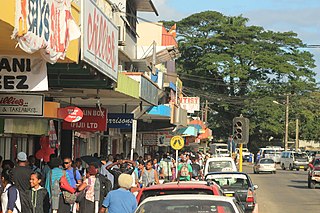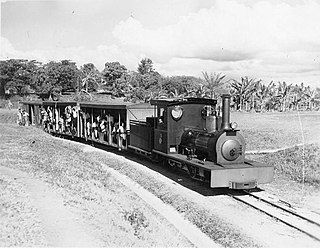List of sugar cane railways

- Labasa Mill Tramway, 1894 to 1982
- Rarawai–Kavanagasau Light Railway, from 1914
Sugar cane grew wild in Fiji and was used as thatch by the Fijians for their houses (bures). The first attempt to make sugar in Fiji was on Wakaya Island in 1862 but this was a financial failure. With the cotton boom of the 1860s there was little incentive to plant a crop that required high capital outlay but after a slump in cotton prices in 1870, the planters turned to sugar. In an effort to promote the production of sugar in Fiji, the Cakobau Government, in December 1871, offered a 500-pound reward for the first and best crop of twenty of sugar from canes planted before January 1873.
The first cane sugar mill in Fiji was built in 1872 by Brewster and Joske near to the present site of the Government Buildings in the capital city of Suva. [1] By the end of 1874, there were four mills in operation, six by the end of 1875 and ten by the end of 1878. Most of these mills crushed for only a few years and only a few survived the crash in sugar price of 1884. The surviving mills were Navua Sugar Mill, Panang Mill, Holmshurst (Taveuni) and the Rewa Sugar Company (Koronivia).
The arrival of the Colonial Sugar Refining Company led to the establishment of Commercially viable sugar mills. In 1880, John Bates Thurston went to Australia seeking investment for Fiji and persuaded the Colonial Sugar Refining Company (CSR) to extend its operations to Fiji. The first mill built by the CSR was the Nausori Sugar Mill on the banks of the Rewa River and began crushing in the 1882 crushing season. In 1883, construction began for its second mill in Ba, the Rarawai Mill. Another mill was built at Viria, also on the Rewa River, and crushed from 1886 to 1895. It was closed because it was too small to be viable. In 1890, the Labasa Mill was erected from a dismantled mill in Queensland.
By 1926 all other sugar mills had closed down and the CSR owned the five existing mills in Fiji of which Nausori mill closed down in 1959.

Modes of transport in Fiji include rail, road, water, and air. The rail network is mainly used for movement of sugar cane. Suva and Lautoka are the largest seaports. There are 122 km of navigable inland waterways. There are two international airports, one other paved airport, and over 20 with unpaved runways. With 333 tropical islands that make up this country, one can expect to use various modes of transport to get to their destination.

Lautoka is the second largest city in Fiji. It is on the west coast of the island of Viti Levu, in the Ba Province of the Western Division. Lying in the heart of Fiji's sugar cane-growing region, the city has come to be known as the Sugar City. Covering an area of 32 square kilometres, it had a population of 71,573 at the 2017 census, the most recent to date.
CSR Limited is a major Australian industrial company, producing building products and having a 25% share in the Tomago aluminium smelter located near Newcastle, New South Wales. It is publicly traded on the Australian Securities Exchange. In 2021, it had over 3,000 employees and reported an after-tax profit of $146 million. The company has a diversified shareholding with predominantly Australian fund managers and retail owners. The group's corporate headquarters is in North Ryde, Sydney.

Air Fiji was an airline based in Nausori, Fiji. It operated inter-island services to destinations within the Fijian Islands. Its main base was Nausori International Airport, Suva, with a base at Nadi International Airport.

Nausori is a town in Fiji. It had a population of 57,866 at the 2017 census. This makes it the fourth most populous municipality in the country. Situated 19 kilometers outside of Suva, it forms one pole of the burgeoning Suva-Nausori corridor. Nausori is home to three provinces Rewa, Tailevu and Naitasiri.

The Fiji Football Association is the governing body of football in Fiji. It came into existence in 1961. It is the overseeing body of the Fiji National Team and its leagues.
The Colonial Sugar Refining Company (CSR) began operations in Fiji in 1880 and until it ceased operations in 1973, had a considerable influence on the political and economic life of Fiji. Prior to its expansion to Fiji, the CSR was operating Sugar Refineries in Melbourne and Auckland. The decision to enter into the production of raw sugar and sugar cane plantation was due to the Company's desire to shield itself from fluctuations in the price of raw sugar needed to run its refining operations. In May 1880 Fiji's Colonial Secretary John Bates Thurston persuaded the Colonial Sugar Refining Company to extend their operations into Fiji by making available 2,000 acres (8 km²) of land to establish plantations.
There have been numerous sugar cane farmers−growers trade unions in Fiji and in the preceding British Colonony of Fiji (1874−1970).
The Inter-District Championship (IDC) is the amateur Fijian football cup. Only five teams first took part in the first IDC held in Suva in 1938. From 1938 to 1975, the competition was initially held on a knock out format but in 1976 pool play was introduced. From 1985, the competition was held in two divisions with the introduction of a second level tournament known as the Premier Division. In 1999 there was a short lived third level division. With Navua registering its first ever win of the IDC tournament in 2009, all the current Super Premium Division teams have now won the Lloyd Farebrother Trophy one or more time(s).
Fiji Sugar Corporation (FSC) is the government-owned sugar milling company in Fiji having monopoly on production of raw sugar in Fiji. It is also the largest public enterprise in the country employing nearly 3,000 people, while another 200,000 or more depend on it for their livelihood in rural sugar cane belts of Fiji.
Savusavu F.C. is a Fijian football team playing in the second division of the Fiji Football Association competitions. It is based in Savusavu, which is a situated on the southern side of the island of Vanua Levu.
Sir Sathi Narain KBE was a Fiji Indian businessman who built a construction and shipping business.
Rail transport in Fiji moves cut sugar cane to crushing mills. Also, there used to be two horse-drawn street tramway systems, some other passenger systems, an underground mine system, and some tramways on construction projects. There are multiple other modes of transport in Fiji.
This is a synopsis of organisations formed by Indians in Fiji. When they became free from the bondage of indenture and were able to organise themselves, they founded numerous organizations to seek social and political justice. These organisations promoted the teaching of Indian languages and religious practices and also to help others in time of need. Some of the successful organisations are listed below in the order in which they were established. Some, such as the National Federation Party, are no longer exclusively Indian, but are still predominantly so.
The Penang Sugar Mill in Rakiraki, Fiji was one of the four sugar mills operated by the Fiji Sugar Corporation. The FSC is the sole producer of raw sugar in Fiji.
The Colonial Sugar Refining Company built a mill at Viria, on the Rewa River, on the southern side of the island of Viti Levu on Fiji. It crushed from 1886 to 1895 and was closed because it was too small to be viable. Sugarcane grown along the Waidina river was transported by rail to the Viria mill through a tunnel in a nearby hill range.
The sport of football in the country of Fiji is run by the Fiji Football Association. The association administers the national football team as well as the FPL. The national team has had little international success.

Radio Fiji One (NA DOMOIVITI) is an iTaukei (Fijian) language - public service broadcaster in Fiji. The station broadcasts on the 93megahertz and 558 kilohertz to the cities of Suva, Navua, Nausori, Labasa, Savusavu, Nadi, Denarau, Mamanuca and Lautoka. The station also broadcasts on the 92.8 frequency to the towns of Coral Coast and Ba. The station broadcasts on 93.2 megahertz to the town of Tavua, and on 93.4 megahertz to Rakiraki and Nabouwalu.
The 2014 Fiji National Football League was the 38th season of the Fiji Premier League administered by the Fiji Football Association (FFA) since its establishment in 1977. The home and away season began on 18 January 2013 and the final was on 17 May 2014. Ba FC and Nadi FC represented the Fiji National Football League in the 2013–14 OFC Champions League after finishing as Champions and Runners-up respectively in the 2013 Fiji National Football League competition.

The Rarawai–Kavanagasau Light Railway was a 142 miles (229 km) long narrow gauge railway on Fiji.
{{cite book}}: CS1 maint: location missing publisher (link)